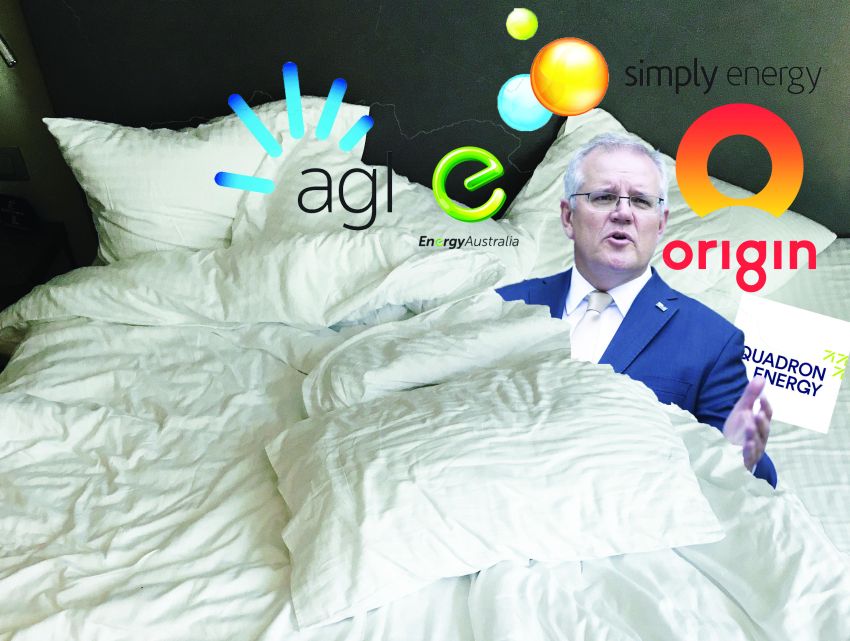
Australian governments of both stripes have long demonstrated a cosy relationship with the gas industry.
Staff movements back and forward between fossil fuel corporations, ministerial offices and peak industry groups are legendary, and sinecures on the boards of companies (and industry peak bodies and lobby groups) are a rite of passage for retiring MPs and ministers.
In this country, this is entirely legal.
A COVID-19-era example of the revolving door between gas oligarchy and government is the National COVID-19 Coordinating Commission (NCCC), a “public-private advisory board”. Established in March 2020, ostensibly to address the pandemic economic recovery, it had a built-in bias towards the gas industry.
The hand-picked body comprises corporate mining and energy sector CEOs and Greg Combet, the former Australian Council of Trade Union leader and Minister for Climate Change and Energy Efficiency in the Julia Gillard government, who subsequently worked as a sub-contractor with gas giant AGL.
It is therefore no surprise that the NCCC’s pandemic “recovery” plan is based on public handouts to the corporate gas giants. Last October’s budget, for example, provided $52.9 million in direct subsidies to gas companies. More than $100 million was promised in the latest budget to subsidise fossil fuels, including $58.6 million specifically for gas projects.
It is clear that the federal government believes its primary role is to support the corporate sector at the expense of workers and the community. It is pulling out all stops to minimise the fetters of regulation and use public monies to guarantee their profits.
As Prime Minister Scott Morrison put it last September: “The government wants the private sector to step up and make timely investments in the gas market. If the private sector fails to act, the Government will step in.”
Government intervention, Morrison continued, could include “streamlining approvals, underwriting projects or the establishment of a special purpose vehicle with a capped Government contribution”.
It also includes countering the development of renewables.
The federal resources minister Keith Pitt made an extraordinary intervention in March, to veto a proposed $280 million loan from the Northern Australia Infrastructure Facility for a wind and battery storage hub in north Queensland.
“I am not convinced that the project will result in lower energy prices,” Pitt wrote in his rejection letter, adding it was “inconsistent with the objectives and policies of the Commonwealth Government”.
The federal budget has been widely slammed for both failing to talk about carbon mitigation while handing over millions to the fossil fuel corporations.
350.org Australia spokesperson Lucy Manne said that the federal government had handed $104.3 million to the gas industry. That includes $30 million for billionaire Andrew Forrest’s Port Kembla Gas Power Station, $15.7 million for gas companies in Queensland’s North Bowen and Galilee Basin and $58.6 million for gas infrastructure and associated plans for an import terminal on the east coast. It follows a commitment of $52.9 million made in last year’s federal budget.
Manne said total government spending on the gas industry in the past 12 months is between $550 million and $944 million. The budget includes support for Squadron Energy, backed by Forrest, to build a new gas import terminal at Port Kembla on the NSW South Coast. It allocates $32 million for a new gas storage and processing facility at Golden Beach in southern Victoria. It allocates funding to expand the South West Victorian Pipeline and the development of the Wallumbilla Gas Supply Hub in Queensland.
Environment groups have also criticized the allocation of $263 million for failed carbon capture technology. Greenpeace Australia’s Dr Nikola Čašule said it was not good enough to treat the symptoms of climate change and “not tackle the root cause: the burning of fossil fuels”.
“What’s worse,” Čašule said, “it’s throwing money at fossil fuel infrastructure and false solutions like Carbon Capture and Storage that only entrench the use of coal, oil and gas.”
Alex Fuller, national director of the Australian Youth Climate Coalition, agreed, saying that instead of funding gas, “public money should be used for a ‘clean energy transition’”.
Clean Energy Council Chief Executive Kane Thornton said the budget was an opportunity to deliver a “clean recovery”.
“A clean recovery from COVID-19 could have delivered over $50 billion of investment, more than 30,000 megawatts of capacity in renewable energy and more than 50,000 new jobs in constructing these projects, along with many more indirect jobs, revitalising economic activity in regional and rural communities across Australia.”
If this was an election budget, as some say, activists have a big job ahead to build the campaign for a clean energy transition to renewable energy. Demanding that public funds be reallocated from gas and fossil fuels towards renewable energy projects would be a good first step.
[Join the Student Strike For Climate on May 21 in your city.]